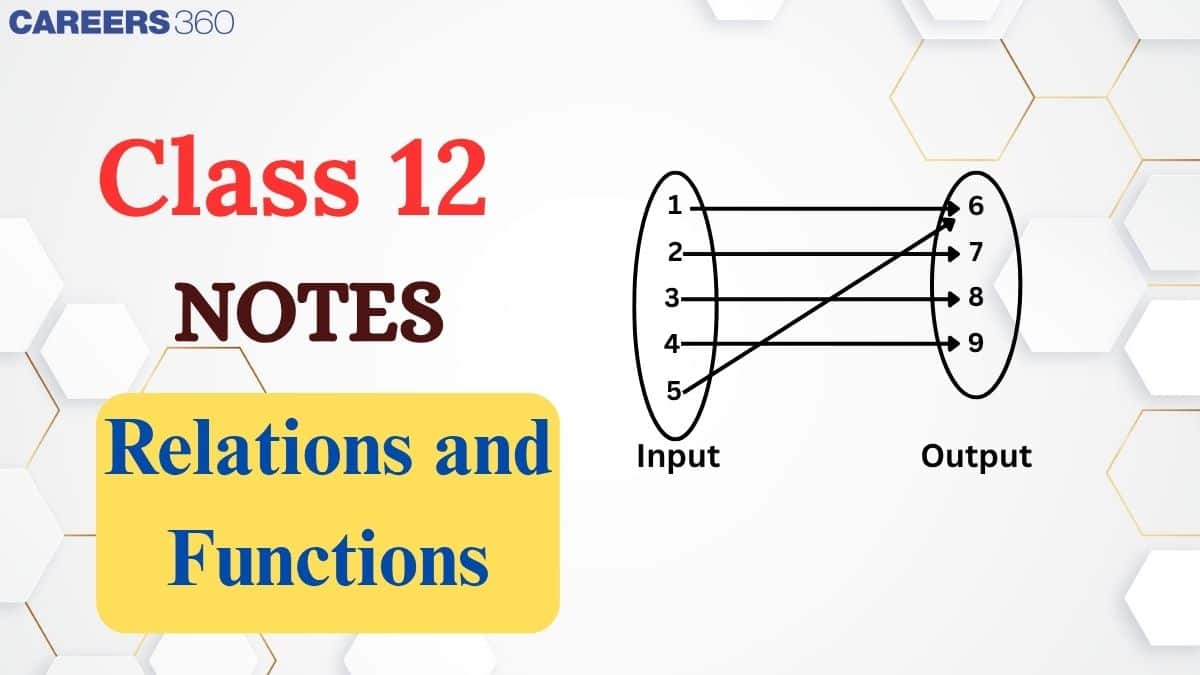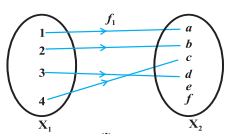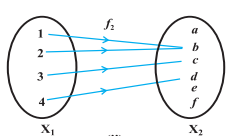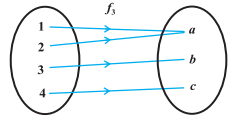NCERT Class 12 Maths Chapter 1 Notes, Relations and Functions Class 12 Chapter 1 Notes
Imagine you are hungry and go online to check the prices to order food. You can see there is a particular price to be paid for every type of item. So, here we can see the relationship between food and its prices. Also, we can see an example of a function where one price is associated with one particular item. In the NCERT Class 12 Maths Chapter 1 Notes, students learn about Relations and Functions, which is an important concept of Mathematics. Students should already have an idea about the basic concepts of this chapter from the previous class. The main purpose of these NCERT Notes is to provide students with an efficient study material from which they can revise the entire chapter. This chapter has good weightage in the CBSE Class 12 Board Exam as well as in competitive exams such as JEE Main and JEE Advanced.
This Story also Contains
- Relations and Functions Class 12 Notes PDF Download
- NCERT Notes for Class 12 Maths Chapter 1 Relations and Functions
- How to Use the Relations and Functions Class 12 Notes Effectively?
- Relations and Functions Class 12 Notes: Previous Year Question and Answer
- NCERT Class 12 Maths Notes Chapter-Wise Links

After completing the textbook exercises and solutions, students need study materials that help them recall concepts more quickly. Relations and functions Notes Class 12 are very useful in this case. In these NCERT Class 12 Maths Notes, everything from definitions and properties to detailed notes, formulas, figures, and solved examples is fully covered by our subject matter experts at Careers360 to help the students understand the important concepts and feel confident about their studies. Find everything in one place – NCERT Books, Solutions, Syllabus, and Exemplar Problems with Solutions – in this NCERT article.
Also Read,
Relations and Functions Class 12 Notes PDF Download
Use the link below to download the PDF version of NCERT Class 12 Maths Chapter 1 Notes for free. After that, you can view the PDF anytime you desire without internet access. It is very useful for revision and last-minute studies.
NCERT Notes for Class 12 Maths Chapter 1 Relations and Functions
Careers360 has prepared these NCERT Class 12 Maths Chapter 1 Notes to make your revision smoother and faster.
Relations
Two sets $A$ and $B$ are said to be related if there is a clear connection or link between their elements. Let $a$ be an element of set $A$ and $b$ be an element of set $B$. If $(a, b) \in R$, then we say that $a$ is related to $b$ under the relation $R$. This is written as $a R b$.
Let a relation $R$ be defined as $R: A \rightarrow B$.
Example:
If $A=\{1,2,3\}$ and $B=\{a, b, c\}$, then
$R=\{(1, b),(2, c),(1, a),(3, a)\}$, which is a subset of $A \times B$, is a relation from $A$ to $B$.
Since $(1, b),(2, c),(1, a)$, and $(3, a)$ belong to $R$, we write $1 R b, 2 R c, 1 R a$, and $3 R a$.
Total Number of Relations: Let A and B be two non-empty finite sets consisting of m and n elements, respectively. Then A x B consists of mn ordered pairs. So, the total number of subsets of A x B is 2mn.
Domain: The set of all first elements of the ordered pairs in a relation R from a set A to a set B is called the domain of the relation R.
Domain of $\mathrm{R}\{\mathrm{a}:(\mathrm{a}, \mathrm{b}) \in \mathrm{R}\}$
Range: The set of all second elements in a relation R from a set A to a set B is called the range of the relation R.
Range of $R\{b:(a, b) \in R\}$
Co-domain: The whole set B is called the co-domain of the relation R.
Note: Range is a subset of the co-domain. Every element of the range must belong to the co-domain, but not every element of the co-domain needs to be in the range.
Types of Relations
Empty Relation: No element of $A$ is related to any element of $A$, i.e.,
$
\mathrm{R}=\phi \subset \mathrm{A} \times \mathrm{A}
$
Universal relation: Each element of $\operatorname{set} \mathrm{A}$ is related to every element of $\operatorname{set} \mathrm{A}$ i.e.
$
\mathrm{R}=\mathrm{A} \times \mathrm{A}
$
Note: Both an empty relation and a universal relation are called a trivial relation.
Identity Relation: A relation R on A is called the identity relation if every element of A is related to itself only. Let A be a set. Then the relation R = {(a, a) : a belongs to A} on A is called the identity relation on A.
Reflexive Relation: A relation R on a set A is said to be reflexive if every element of A is related to itself. If $(a,a) \in R$ for every $a\in A$.
Note: Every Identity relation is reflexive, but every reflexive relation is not an identity.
Symmetric Relation: if $\left(a_1, a_2\right) \in \mathrm{R} \Rightarrow\left(a_2, a_1\right) \in \mathrm{R}\ {\text {for all }} a_1, a_2 \in \mathrm{~A}$
Transitive Relation: if $\left(a_1, a_2\right) \in \mathrm{R}$ and $\left(a_2, a_3\right) \in \mathrm{R} \Rightarrow\left(a_1, a_3\right) \in \mathrm{R}$ for all $a_1, a_2, a_3 \in \mathrm{~A}$
Equivalence Relation: If a relation R is reflexive, symmetric, and transitive, then it is said to be an equivalence relation.
Functions
The function is a binary relation between two sets A and B that associates each element of set A with exactly one element of set B. So, if a vertical line cuts a given graph at more than one point, then it can not be the graph of a function.
Note: Every function is a relation, but every relation is not necessarily a function.
Let a function 'f' be defined as $f: A→B$.
Set A is called the domain of the function.
Set B is called the co-domain of the function.
The set of 'f' images of all the elements of set A is known as the range of the function 'f'.
Types of Functions
There are many types of functions we need to learn about, some of the important ones are:
Injective function: A function $f$ is called injective if the images of distinct elements of $A$ under $f$ are distinct.
If function $f: \mathrm{A} \rightarrow \mathrm{B}$ is defined for every $a_1, a_2 \in \mathrm{~A}, f\left(a_1\right)=f\left(a_2\right)$ $\Rightarrow a_1=a_2$. Then this is one-one function.

Many-one function: A function f is called many-one if the images of distinct elements of A under f can be the same.

Surjective function: A function $f: X→Y$ is called Surjective if every element of $Y$ is the image of some element of $X$.

Composition of Functions and Invertible Functions
If function $f: A \rightarrow B$ and $g: B \rightarrow C$ are two functions then the composite function of two functions 'f' and 'g' is $g \circ f: A \rightarrow C$ is defined as $g \circ f(x)=g(f(x)) \forall x \in A$.

Example:
If $f(x)=8 x^3$ and $g(x)=x^{\frac{1}{3}}$ than find $\mathrm{f}(\mathrm{g}(\mathrm{x}))$ and $\mathrm{g}(\mathrm{f}(\mathrm{x}))$
Solution:
The solution is as follows
$
\begin{aligned}
& \text { (ii) } f(x)=8 x^3 \text { and } g(x)=x^{\frac{1}{3}} \\
& \text { g o f }=g(f(x)) \\
& =g\left(8 x^3\right) \\
& =\left(8 x^3\right)^{\frac{1}{3}} \\
& =2 x
\end{aligned}
$
$\begin{aligned} & \text{f o g}=f(g(x)) \\ & =f\left(x^{\frac{1}{3}}\right) \\ & =8\left(\left(x^{\frac{1}{3}}\right)^3\right) \\ & =8 x\end{aligned}$
Inverse function:
If function $f: \mathrm{A} \rightarrow \mathrm{B}$ be a one-one and onto function, then there exists a unique function $g: \mathrm{B} \rightarrow \mathrm{A}$ such that
$f(x)=y \Leftrightarrow g(y)=x$ $\forall x \in A \quad \& \quad y \in B$.
The function g is the inverse of f.
$g=\mathrm{f}^{-1}: \mathrm{B} \rightarrow \mathrm{~A} .$
Example:
If the function $f(x)=4 x+3$ is defined $f: R \rightarrow R,$ then find the inverse of $f$.
Solution:
$
\begin{aligned}
& f(x)=4 x+3 \\
& y=4 x+3, y \in R \\
& \Rightarrow x=f^{-1}(y)=\frac{y-3}{4} \in R
\end{aligned}
$
Algebraic Operations on Functions
Let two real-valued functions f & g be given with domain sets A, B, respectively.
(i) (f + g ) ( x) = f(x) + g(x) (domain is $A \cap B$ )
(ii) (f - g ) ( x) = f(x) - g(x) (domain is $A \cap B$ )
(iii) (f . g ) ( x) = f(x) g(x) (domain is $A \cap B$ )
(iv) $(\frac fg ) ( x) =\frac{ f(x)}{g(x)}$ (domain is $A \cap B$ - { x | g(x) = 0 } )
Binary Operations
Binary operation * on a set A is a function $*: A \times A \rightarrow A$. Binary operation * is denoted $*(a, b)$ as $a * b$.
- Commutative property: If $a * \mathrm{~b}=\mathrm{b} * \mathrm{a}$ for every $\mathrm{a}, \mathrm{b} \in \mathrm{A},{\text {than * }}$ is commutative on A.
- Associative property: If $(a * \mathrm{~b}) * c=a *(\mathrm{~b} * \mathrm{c})$ for every $\mathrm{a}, \mathrm{b}, c \in \mathrm{~A},{\text {than }}$ * is associative on $A$.
- Identity: If an element e in set A exists such that $a * \mathrm{e}=\mathrm{a}=\mathrm{e} * \mathrm{a}, \forall \mathrm{a} \in \mathrm{A}$ then ' e ' is an identity element for * on set A.
Note: Zero is the identity for the addition operation on R, but not on N, as 0 doesn't belong to N.
How to Use the Relations and Functions Class 12 Notes Effectively?
Relations and Functions is the first chapter of Class 12 Maths, and it builds the base for many important topics. This chapter helps us understand how different values are connected and how functions work. This chapter is very important for JEE, and using Class 12 Maths chapter 1 notes properly can really improve our score. Here are some more points on how these notes are important.
- First, clearly understand the types of relations and types of functions, as most questions are based on these basics.
- Practice the composition of functions and inverse functions step by step, because these require regular problem-solving.
- This chapter is beneficial in higher classes and many competitive exams, especially in calculus, so revising from the NCERT Class 12 Maths chapter 1 notes will help you a lot in the future.
Relations and Functions Class 12 Notes: Previous Year Question and Answer
Given below are selected previous year question answers for NCERT Class 12 Maths Chapter 1 Relations and Functions, collected from various examinations.
Question 1: Assertion (A): Let $Z$ be the set of integers. A function $f: Z \rightarrow Z$ defined as $\mathrm{f}(x)=3 x-5, \forall x \in \mathrm{Z}$ is a bijective.
Reason (R): A function is bijective if it is both surjective and injective.
Choose the correct option from below:
(1.) Both Assertion (A) and Reason (R) are true, and the Reason (R) is the correct explanation of the Assertion (A).
(2.) Both Assertion (A) and Reason (R) are true, but Reason (R) is not the correct explanation of the Assertion (A).
(3.) Assertion (A) is true, but Reason (R) is false.
(4.) Assertion (A) is false, but Reason (R) is true.
Solution:
Assertion (A):
Let $\mathbb{Z}$ be the set of integers.
A function $f: \mathbb{Z} \rightarrow \mathbb{Z}$, defined as
$f(x)=3x-5, \forall x \in \mathbb{Z}$ is a bijection.
Injectivity (One-one)
Let $f\left(x_1\right)=f\left(x_2\right)$
$\Rightarrow 3 x_1-5=3 x_2-5$
$\Rightarrow x_1=x_2$
So, $f$ is injective.
Surjectivity (Onto)
We want to see if every integer $y \in \mathbb{Z}$ has some $x \in \mathbb{Z}$ such that $f(x)=y$
Let $y=3 x-5 \Rightarrow x=\frac{y+5}{3}$
Now, for arbitrary $y \in \mathbb{Z}, \frac{y+5}{3}$ is not always an integer (e.g., if $y=1 \Rightarrow x=\frac{6}{3}=2$
but if $y=0 \Rightarrow x=\frac{5}{3} \notin \mathbb{Z}$)
So, not every integer $y$ has a pre-image $\rightarrow f$ that is not onto.
Hence, $f$ is not bijective.
Reason (R):
"A function is bijective if it is both surjective and injective."
$\rightarrow$ This is true by definition.
Therefore, Assertion (A) is false, but Reason (R) is true.
Hence, the correct answer is option (4).
Question 2: If $f: R \rightarrow R$ be given by $f(x)=\tan x$, then $f^{-1}(1)$ is:
Solution:
Here, $f(x)=\tan x$
Assume, $f(x)=y=\tan x$
Then, $\quad x=\tan ^{-1}(y)$
or, $f^{-1}(x)=\tan ^{-1}(x)$
or, $f^{-1}(1)=\tan ^{-1}(1)$
or, $f^{-1}(1)=\tan ^{-1} \tan (\frac{\pi}{4})=\frac{\pi}{4}$
Hence, the correct answer is $\frac{\pi}{4}$.
Question 3:
Let $\mathrm{f}: R \rightarrow R$ be defined by
$
f(x)= \begin{cases}2 x & \text { when } x>3 \\ x^2 & \text { when } 1<x \leq 3 \\ 3 x & \text { when } x \leq 1\end{cases}
$
The expression $(f(-1)+f(2)+f(4))$ is :
Solution:
Here, $f(-1)+f(2)+f(4)$
$=3(-1)+(2)^2+2(4)$
$=-3+4+8=9$
Hence, the correct answer is $9$.
NCERT Class 12 Maths Notes Chapter-Wise Links
We at Careers360 compiled all the NCERT class 12 Maths notes in one place for easy student reference. The following links will allow you to access them.
|
NCERT Class 12 Maths Chapter 1 Notes |
NCERT Exemplar Solutions – Subject Wise
After finishing the textbook exercises, students can use the following links to check the NCERT exemplar solutions for a better understanding of the concepts. The NCERT Exemplar Class 12 solutions are a perfect guide to clear your doubts and learn smart problem-solving techniques.
- NCERT Exemplar Class 12 Maths
- NCERT Exemplar Class 12 Physics
- NCERT Exemplar Class 12 Chemistry
- NCERT Exemplar Class 12 Biology
NCERT Solutions – Subject Wise
Students can also explore these well-structured, subject-wise Class 11 solutions for better understanding.
NCERT Books and Syllabus
Students should always analyse the latest NCERT syllabus before making a study routine. The following links will help them check the syllabus and access some reference books.
Frequently Asked Questions (FAQs)
A relation shows a connection between elements of two sets, where one input can have multiple outputs.
A function is a special type of relation where each input has exactly one output.
The important topics covered in the Class 12 Notes for Maths chapter 1, Relations and Functions are: Types of Relations, Types of Functions, Composition of Functions and Invertible Functions.
From definitions and properties to detailed notes, formulas, diagrams, and solved examples, everything is provided in the NCERT notes to help the students prepare for their board exams and feel confident about their studies. These Notes are an easy-to-read and well-organised overview of everything in the chapter.
The domain is the set of all first elements of ordered pairs, the co-domain is the set containing all possible second elements, and the range is the set of actual second elements used in the relation.
The various types of relations are: Empty Relation, Reflexive Relation, Symmetric Relation, Transitive Relation, Anti-symmetric Relation, Universal Relation, Inverse Relation, and Equivalence Relation.
Popular Questions
Courses After 12th
Applications for Admissions are open.
As per latest syllabus. Physics formulas, equations, & laws of class 11 & 12th chapters
JEE Main Important Chemistry formulas
Get nowAs per latest syllabus. Chemistry formulas, equations, & laws of class 11 & 12th chapters
JEE Main high scoring chapters and topics
Get nowAs per latest 2024 syllabus. Study 40% syllabus and score upto 100% marks in JEE
JEE Main Important Mathematics Formulas
Get nowAs per latest syllabus. Maths formulas, equations, & theorems of class 11 & 12th chapters
